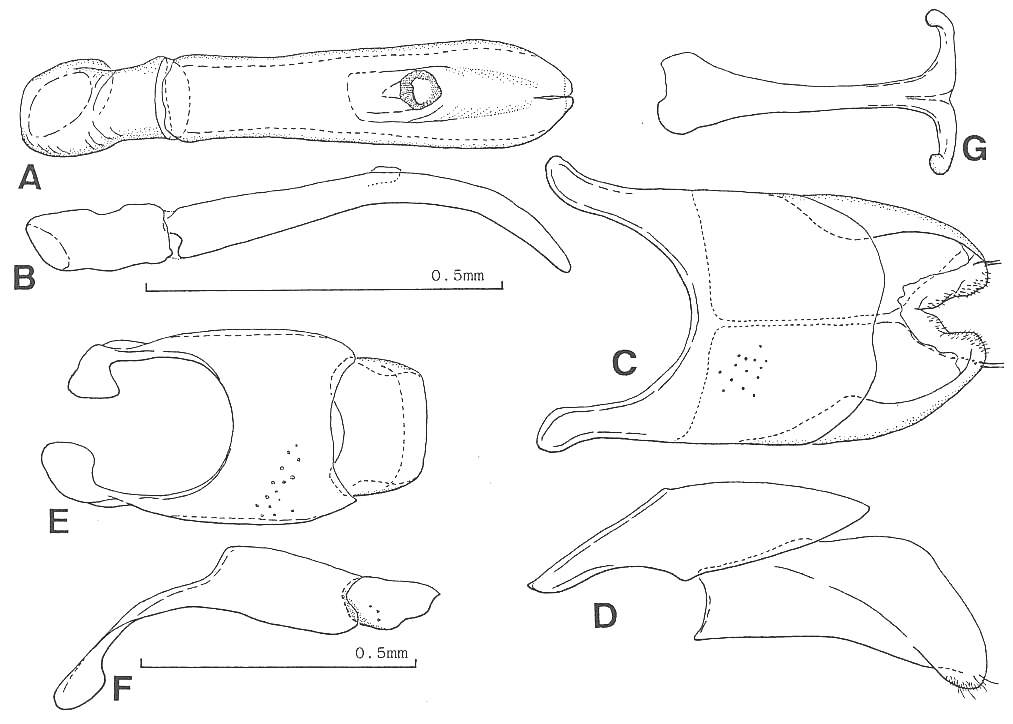
Saprinus subaeneus Schmidt, 1890: 53 [Japan: Nikko].
Hypocaccus subaenus: Schleicher, 1930: 137; Reichardt, 1941: 308, 321.
Hypocaccus (? Hypocaccus) subaenus: Kryzhanovskij and Reichardt, 1976: 229.
Japanese name: Yama-hamabe-emma-mushi.
Hypocaccus (Hypocaccus) subaenus (sic): Ôhara, 1994, 250; Ôhara and Paik, 1998: 29.
Hypocaccus (Hypocaccus) subaeneus: Ôhara, 1998, 3.
Saprinus subaeneus Schmidt, 1890, 53.
Hypocaccus (Hypocaccus) subaenus (sic): Ohara, 1994, 250; Ohara and Paik, 1998: 29.
Hypocaccus (Hypocaccus) subaeneus: ESK & KSAE, 1994, 136 [Korea]; Ohara, 1998, 3.
Description. Body length, PPL, 2.22 - 2.91 mm (2.48 ± 0.04, n=20), PEL, 2.03 - 2.62 mm (2.27 ± 0.03, n=20). Width, 1.70 - 2.22 mm (1.92 ± 0.03, n=20). Biometric data are given in Table 51. Body oval and moderately convex. Cuticles shining and black or nearly so with bronzy, blue or brassy lustre; antennae dark rufopiceous with club rufotestaceous; legs dark reddish brown.
Frontal stria of head (Fig. 142B) complete, carinate and straight on each side. Supraorbital stria complete. Disk of front scabrose on apical two-thirds, sometimes scabrose wholly. Epistoma scabrose.
Pronotal sides (Fig. 140B) feebly arcuate and convergent on basal four-fifths, then strongly arcuate and convergent to apices. Apical angles round. Marginal stria carinate and complete. Disk coarsely and densely punctate except mediobasally, the punctures becoming more rugose on lateral region; base with two or three transverse rows of coarse punctures with fine ones intermingled, the rows broadest at middle and becoming progressively narrower laterally.
Epipleura of elytra sparsely clothed with fine punctures. Marginal epipleural stria complete and feebly carinate. Marginal elytral stria complete and well carinate, its apical end extending near to lateral sixth of elytron. External subhumeral stria absent. Internal subhumeral stria shortly present on median third. Oblique humeral stria well impressed on basal third. First dorsal stria deeply impressed and crenate on basal four-fifths. Second dorsal stria present on basal three-fifths. Third dorsal stria a little longer than the 2nd. Fourth dorsal stria present on basal half. Sutural stria represented by a fine complete line. Surface of elytra smooth on basal half, and densely covered with coarse punctures on apical half and sometimes also on basal area between 4th dorsal and marginal elytral striae, the punctures often rugose; extreme apex of elytra (around apical stria) and flanks impunctate, but sometimes flanks coarsely punctate.
Propygidium densely covered with coarse punctures, which become finer and sparser towards base. Pygidium convex, and densely and moderately punctate, the punctures sparser apically and medially.
Anterior margin of median portion of prosternum (Fig. 141B) obtusely angulate or round. Preapical foveae distinctly present. Keel somewhat broad, and moderately compressed medially, the apex round. Descending lateral striae complete, carinate, and convergent at apex. Carinal striae present on basal two-thirds, convergent apically and united with each other, rarely completely present, its apical end attaining to the apex of keel. Lateral side of keel sparsely with moderate punctures, with fine punctures intermingled.
Anterior margin of mesosternum feebly emarginate medially, its marginal stria well impressed on each side behind angle, usually interrupted in median third, rarely complete. Disk transverse (19 : 5), evenly clothed with fine or moderate punctures. Meso-metasternal suture finely impressed, accompanied with a parallel coarsely crenated line. Intercoxal disk of metasternum sparsely clothed with fine punctures, and with a transverse apical band of sparse and moderate punctures. Lateral metasternal stria well impressed, carinate, extending obliquely and posteriorly, and reaching near hind coxa. Lateral disk densely and largely punctate, the punctures becoming sparser apically. Metepisternum densely covered with large punctures.
Intercoxal disk of 1st abdominal sternum completely and crenately striate on each side, and moderately punctate along posterior margin and inside the lateral striae.
Table 51. Biometeric data of Hypocaccus subaenus (Shmidt).
----------------------------------------------------------------------
APW 0.62-0.78 (0.71±0.01) 20
PPW 1.50-1.96 (1.69±0.02) 20
PL 0.75-0.95 (0.85±0.01) 20
EL 1.28-1.70 (1.42±0.02) 20
EW 1.70-2.22 (1.92±0.03) 20
ProW 0.92-1.41 (1.13±0.03) 20
ProL 0.26-0.39 (0.31±0.01) 20
PyL 1.00-1.33 (1.14±0.02) 20
PTL 0.59-0.75 (0.66±0.01) 20
MSTL 0.56-0.75 (0.67±0.01) 20
MTTL 0.65-0.88 (0.78±0.01) 20
-----------------------------------------------------------------------
Protibia with 8 spinules on outer margin.
Male genitalia as shown in Fig. 146

Remarks. Hypocaccus subaenus can easily be distinguished by the front of the head with coarse rugae, the dense punctation of the pronotum, the mesosternum with coarse punctures and the interrupted mesosternal marginal stria.
Hypocaccus subaenus usually occurs on the sandy beach of mountain rivers. Some specimens were collected under dung of bear, Ursus arctos Linné, on the beach of a river.
[Hokkaidô] 8 exs., Mt. Ôhirayama, 29/v, 6-8/viii/1988, M. Ôhara leg., from dung of bear; 56 exs., Toyotaki, Jôzankei, 4, 6/vi, 14/vii/1986, 1/v, 3, 18/vi1987, M. Ôhara leg.
[Honshû] <Kyôto-fu> 1 ex., Kurama, 4/vi/1933, T. Kimura leg. (NA).
Specimens examined [additional records]. (Ohara, 1999a).
[Honshu] Aomori-ken: Oirasegawa, Fukaura-machi (1 ex., 9/vi/1978, APM), A. Abe; (1 ex., 1/vii/1988), S. Yamauchi. Nara-ken: Sannokou, Kawakami (1 ex., 22/v/1994, SA), H. Otobe. Shiga-ken: Miyagahama, Oumi-hachiman, alt. 85 m, MC52366026 (1 ex., 5/vi/1994, OMD-940605.092), S. Shiyake; Marima, Hikone, alt. 85 m, MC52366172 (1 ex.: , 5/vi/1994, OMD-940605.039), S. Shiyake.
